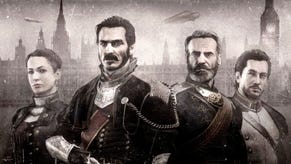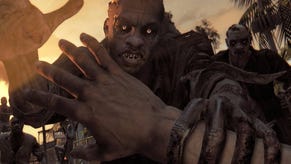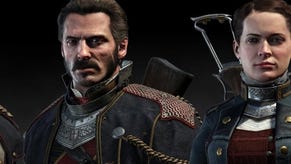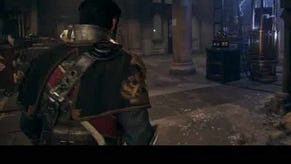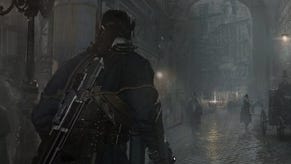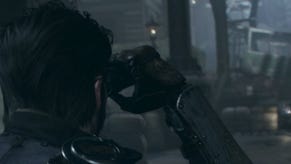How Uncharted influenced PS4 exclusive The Order: 1886
Ready at Dawn reappears with its shot at the big time.
It wasn't any moment in particular that inspired PlayStation 4 exclusive The Order: 1886; it was the feeling Ready at Dawn co-founder Ru Weerasuriya had after completing Uncharted 2.
It was a feeling that, four years after Naughty Dog's incredible action game released for the PlayStation 3, Weerasuriya still struggles to pin down.
"It's that emotion they created in people," Weerasuriya, who 10 years ago co-founded the California developer of the PlayStation Portable God of War games after a stint at Blizzard working as an artist, tells me in a cool, calm hotel room set away from the chaotic whirlwind of Gamescom's Koelnmesse.
"I remember even before the first Uncharted was released, internally there were talks of it. We know the Naughty Dog guys really well. They're very close to where we are and very close to us in so many ways as a team.
"We realised what they were trying to create. The first one came out and they were setting up an IP. And then with the second game suddenly they created an emotion in people of that Hollywood blockbuster."
Uncharted 2 launched to critical and commercial acclaim, but more importantly it sent shockwaves throughout the game industry, changing forever the idea of what a cinematic video game could be and sparking a horde of developers to emulate its design. Nathan Drake did Indiana Jones better than Harrison Ford and Tomb Raider better than Angelina Jolie, and everybody loved it.
Uncharted 2 was the push Weerasuriya needed to settle upon Ready at Dawn's shot at the big time - a big budget triple-A home console exclusive of its own after years spent making high quality handheld games in the God of War series.
"We're not trying to emulate things they've done moment to moment," he says. "We're trying to give people that similar sense of entertainment. Entertainment comes in big Hollywood blockbusters and small indie movies - it's that. Games don't do that enough. Sometimes you get just stuck in one gameplay sequence or one thing you do all the way through. They gave us a multitude of things that created a whole. Once you played the game you felt, wow, that was a great ride. That's where the inspiration came from.
"It was one of the first times in my life when I felt, wow, you know what? That was an amazing ride. There was no single moment when I was like, that was just cool and that's the thing I love. The feeling at the end was, I just want more of this. This is what I want to do. This is what gaming is for me. That's what drove us to do this."
The Order: 1886 was announced at E3 in June with an eye-catching in-engine trailer that posed prospective PS4 owners more questions than answers. We know it's set in London in 1886, but it's a steampunk version based on an alternative history 40 years after the Industrial Revolution. According to the official blurb, "Man uses advanced technology to battle a powerful and ancient foe". You play as a member of an elite order of knights, joining a centuries-old war that will determine the course of history forever.
"The feeling at the end was, I just want more of this. This is what I want to do. This is what gaming is for me. That's what drove us to do this."
Ready at Dawn co-founder Ru Weerasuriya
And that was all she wrote, until later in June, when Weerasuriya penned a PlayStation blog post that, again, posed more questions than answers. We discovered that The Order: 1886 is a linear, story-based third-person action adventure with shooting mechanics and moment-to-moment gameplay that's "really not what you might expect". Beyond that, no detail. The Order is real, but it remains a mystery.
A recurring theme is this concept of The Order being "filmic". It's a somewhat abstract term that I at first took to mean cinematic, so, sort of like Uncharted, but Weerasuriya says it's to do with the way Ready at Dawn is shooting the game.
Yes, shooting the game.
"I know it's a word that's been thrown around quite a bit," Weerasuriya admits. "We concentrate on the important part of what makes something feel like a movie. It's not about making a game that just has a string of things that happen, like a movie. But, how can we inject some of the things you've seen in films?
"It's not about one event following another. It's really about how the craft of making a movie is different from the craft of making a game. We are different as industries, but we have so much commonality. One gap we haven't bridged yet is that we create engines, cameras and lighting. All those things are done for the purpose of a game, in a very game centric way. We decided, okay, let's make the gameplay, but let's take the techniques we've seen in movies.
"Like lenses. How do lenses work? We felt we could build gameplay and at the same time build lenses that were real. In the engine, the lenses we shoot with I actually emulated from real lenses I've used to shoot photography. The guy who directs the game with me has done the same. He does cinematography. I do photography in my free time.
"Graphically it's not a question of making things look better because it's a new generation. It's not in how many polygons or how much better the fidelity is. It's those little techniques like chromatic aberration, like lens distortion.
"How do we build lighting and atmosphere around lighting? On movie sets lights are not just lights. They have a light, but they create with smoke or whatever an atmosphere to give this glow to the light that is kinda fake, but in movies you excuse it because you expect it and it's really cool. You're like, wow, that shot has so much depth. It's got atmosphere. It's got thickness. It's got grittiness. That was the stuff we wanted to bring to games.
"That's filmic."
I expected Sony to show The Order gameplay at Gamescom, in light of the game's announcement at E3, but Ready at Dawn isn't ready for that. Instead, behind closed doors presentations focused on the tech powering the game, which has been in the works for a number of years now. But despite Weerasuriya's obvious admiration of Hollywood, The Order is, after all, a video game to be played with the DualShock 4 by gamers who have forked out hundreds of pounds for a next-generation console. Unfortunately Ready at Dawn and Sony aren't talking about the way The Order plays, yet, but I ask anyway: how do all these fancy "filmic" techniques affect gameplay?
"It doesn't affect gameplay, which is the cool part," Weerasuriya replies. "It gives you a sense of immersion you expect out of what you see normally through a TV."
There is no doubt that, like Naughty Dog with Uncharted, Ready at Dawn wants to tell you a story with The Order. Weerasuriya says it's a "story-driven" game, with the aforementioned moment-to-moment gameplay providing a unique twist. What does this mean, exactly?
"It's the way the characters play out, the animations we use, the motion capture sessions we have," Weerasuriya says, his answer as unclear as London drenched in fog. "We try to make sure every single tool we have at our disposal, and that includes gameplay as well, serves the purpose of the goal, which is to drive people through this story.
"Sometimes you have to sacrifice a lot of what you want to do to make sure the gameplay works. We're trying to do it in such a way that there's a better balance between what you've seen. So things are not so segmented, put it that way."
"It doesn't affect gameplay, which is the cool part. It gives you a sense of immersion you expect out of what you see normally through a TV."

As a born and bred Londoner my interest was piqued when I heard the news that The Order was set in my home town. I've always wondered why more games haven't been set in The Big Smoke, making use of its history, landmarks and grime. I maintain a slither of hope that Rockstar North will one day turn its attention south as it ponders a setting for a future entry in the Grand Theft Auto series, but, given Dan Houser's ongoing penchant for satirising the American Dream, I'm doubtful.
And so The Order will do for now.
"I love the city," Weerasuriya says with a smile. "I grew up in Switzerland and I used to travel all around the place. There are a few cities that remain in my head as places I'd love to live in. At every street corner you find something different. You walk around greater London... people talk about America being a melting pot. For me, London feels like that. There's more diversity there than there is anywhere I've seen, and I've lived in the States for 17 years. That's got to do with how the city evolved.
"London affected so much of the world's history in good and bad ways. Monarchy and trading and all of that stuff. I don't think we could make enough games to talk about everything that happened in that single city. And that's the reason why London is the first one. This is where we wanted to have our base, how to kick off the IP, because there is so much we could take out of it."
The Order's London is not the London we know of today. It's not the London we know of of 1886, either. Remember, the game follows an alternative 40 years after the Industrial Revolution, so expect plenty of steampunk gadgets and weapons, some of which are shown off in the debut trailer. But you'll be able to explore well known landmarks, including Big Ben, Westminster Palace and the Houses of Parliament. The London Underground will play a part, too.
"As far as areas of London, we haven't pinpointed every single thing," Weerasuriya says, before suggesting that East London hipsters will feel right at home. "Whitechapel one because Whitechapel has a very interesting history and there are interesting places there. As of now we haven't locked down the full scope of everything we want to do, but I can guarantee you this: it's not going to be all of London."
Bah. No Croydon, then.
"London is a city that has open spaces and small spaces, but it will remain a story-driven game," Weerasuriya says. "You will see places at the beginning of the game you'll see later, you'll see them evolve, you'll have a chance to interact with them and in some ways change the way they are from the beginning to the end.
"That's where we concentrated most of our effort - trying to make sure the story we're trying to tell is complimented by the way we build the city."
"London is a city that has open spaces and small spaces, but it will remain a story-driven game."

With The Order: 1886 Ready at Dawn is finally getting the chance to play with the PlayStation big boys. It's a new intellectual property and so, as per the rules of video game industry engagement, is one hell of a risk, but it's already set up to be a major franchise on PS4.
For amateur photographer Weerasuriya and co it's the dream game Ready at Dawn was founded to create, the reward for work done on three PSP games, a Wii game and a PS3 HD port, its origins forged in ideas scribbled down and saved for later.
"We started off as a small team of three people. 20 people by the time we finished the first game. 30 people by the time we finished the second one. We were slowly trying to get to the point where we learnt everything we needed to make this game."
Speaking to Weerasuriya, I realise he's as much a student of history as he is of film. In fact he's fascinated by it. "When I started writing it was all over the place," he says. "It was spanning a lot of centuries. And when we decided it was time for us to make the game, automatically there was this attraction to post-Industrial Revolution era Europe because of the changes in mankind during that time. There was so much happening in so little time. The world changed from an agricultural society to an industrial. It's amazing how fast that happened, if you really think about it."
But Weerasuriya's history lesson is as much about the real world as it is about the virtual. His passion for the "filmic", for history and for London is matched by his passion for the Uncharted series, created by his fellow Californians at Naughty Dog. He won't copy Nathan Drake's adventures - rather, he wants to rekindle that feeling, that "wow!", we all had upon completing them.
It's hard to explain, he says. When The Order eventually releases and the fog shrouding the game in mystery clears, fingers crossed, we'll feel it for ourselves.



